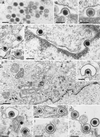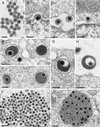Herpesvirus assembly and egress
- PMID: 11799148
- PMCID: PMC135924
- DOI: 10.1128/jvi.76.4.1537-1547.2002
Herpesvirus assembly and egress
Figures




Similar articles
-
Nuclear Egress.Curr Issues Mol Biol. 2021;41:125-170. doi: 10.21775/cimb.041.125. Epub 2020 Aug 7. Curr Issues Mol Biol. 2021. PMID: 32764158 Free PMC article. Review.
-
Nuclear Egress of Herpesviruses: The Prototypic Vesicular Nucleocytoplasmic Transport.Adv Virus Res. 2016;94:81-140. doi: 10.1016/bs.aivir.2015.10.002. Epub 2016 Jan 29. Adv Virus Res. 2016. PMID: 26997591 Review.
-
[Mechanisms of herpesvirus infection--virus entry into host cells and virus assembly].Uirusu. 2007 Dec;57(2):151-8. doi: 10.2222/jsv.57.151. Uirusu. 2007. PMID: 18357753 Review. Japanese.
-
Escape of herpesviruses from the nucleus.Rev Med Virol. 2010 Jul;20(4):214-30. doi: 10.1002/rmv.643. Rev Med Virol. 2010. PMID: 20069615 Review.
-
Intriguing interplay between viral proteins during herpesvirus assembly or: the herpesvirus assembly puzzle.Vet Microbiol. 2006 Mar 31;113(3-4):163-9. doi: 10.1016/j.vetmic.2005.11.040. Epub 2005 Dec 5. Vet Microbiol. 2006. PMID: 16330166 Review.
Cited by
-
RNA nanotechnology to build a dodecahedral genome of single-stranded RNA virus.RNA Biol. 2021 Dec;18(12):2390-2400. doi: 10.1080/15476286.2021.1915620. Epub 2021 Apr 29. RNA Biol. 2021. PMID: 33845711 Free PMC article.
-
Exploitation of Cellular Cytoskeletons and Signaling Pathways for Cell Entry by Kaposi's Sarcoma-Associated Herpesvirus and the Closely Related Rhesus Rhadinovirus.Pathogens. 2012 Dec;1(2):102-27. doi: 10.3390/pathogens1020102. Epub 2012 Oct 22. Pathogens. 2012. PMID: 23420076 Free PMC article.
-
The Role of the Equine Herpesvirus Type 1 (EHV-1) US3-Encoded Protein Kinase in Actin Reorganization and Nuclear Egress.Viruses. 2016 Oct 12;8(10):275. doi: 10.3390/v8100275. Viruses. 2016. PMID: 27754319 Free PMC article.
-
The Torsin Activator LULL1 Is Required for Efficient Growth of Herpes Simplex Virus 1.J Virol. 2015 Aug;89(16):8444-52. doi: 10.1128/JVI.01143-15. Epub 2015 Jun 3. J Virol. 2015. PMID: 26041288 Free PMC article.
-
Characterization and intracellular localization of the Epstein-Barr virus protein BFLF2: interactions with BFRF1 and with the nuclear lamina.J Virol. 2005 Mar;79(6):3713-27. doi: 10.1128/JVI.79.6.3713-3727.2005. J Virol. 2005. PMID: 15731265 Free PMC article.
References
-
- Avitabile, E., P. Ward, C. Di Lazzaro, M. Torrisi, B. Roizman, and G. Campadelli-Fiume. 1994. The herpes simplex virus UL20 protein compensates for the differential disruption of exocytosis of virions and viral membrane glycoproteins associated with fragmentation of the Golgi apparatus. J. Virol. 68:7397-7405. - PMC - PubMed
Publication types
MeSH terms
LinkOut - more resources
Full Text Sources
Other Literature Sources

